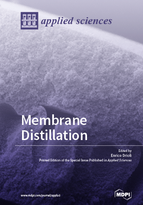Membrane Distillation
A special issue of Applied Sciences (ISSN 2076-3417). This special issue belongs to the section "Chemical and Molecular Sciences".
Deadline for manuscript submissions: closed (20 December 2016) | Viewed by 63957
Special Issue Editor
Interests: membrane science and engineering; membranes in artificial organs; integrated membrane processes; membrane preparation and transport phenomena in membranes; membrane distillation and membrane contactors; catalytic membrane and catalytic membrane reactors; desalination of brackish and saline water; salinity-gradient energy fuel cells
Special Issues, Collections and Topics in MDPI journals
Special Issue Information
Dear Colleagues,
Membrane distillation (MD) is relatively a new membrane process becoming of significant interest, mainly due to its ability to exploit waste grade and low heat for operation and nearly feed concentration-independent production of high-purity distillate. In addition to traditional desalination, the process has been declared feasible for various applications in the pharmaceutical, agrofood, petroleum and nuclear industries. Due to its unique features and a broad sphere of applications, the process has recently gained considerable attention from both academia and industry. Through this Special Issue of Applied Sciences on ‘’Membrane Distillation’’, we are seeking your contribution in this growing field. The Special Issue will cover developments at various forefronts of MD, including membrane preparation, transport phenomenon, fouling and scaling issues, process improvements and applications. The contributions on temperature polarisation phenomenon, new microporous hydrophobic membranes, graphene and 2D materials for membrane preparation and applications in various nontraditional areas, such as space and nuclear sectors, are particularly welcomed. The issue welcomes novel experimental, as well as theoretical investigations carried out to explore these topics.
Prof. Dr. Enrico Drioli
Guest Editor
Manuscript Submission Information
Manuscripts should be submitted online at www.mdpi.com by registering and logging in to this website. Once you are registered, click here to go to the submission form. Manuscripts can be submitted until the deadline. All submissions that pass pre-check are peer-reviewed. Accepted papers will be published continuously in the journal (as soon as accepted) and will be listed together on the special issue website. Research articles, review articles as well as short communications are invited. For planned papers, a title and short abstract (about 100 words) can be sent to the Editorial Office for announcement on this website.
Submitted manuscripts should not have been published previously, nor be under consideration for publication elsewhere (except conference proceedings papers). All manuscripts are thoroughly refereed through a single-blind peer-review process. A guide for authors and other relevant information for submission of manuscripts is available on the Instructions for Authors page. Applied Sciences is an international peer-reviewed open access semimonthly journal published by MDPI.
Please visit the Instructions for Authors page before submitting a manuscript. The Article Processing Charge (APC) for publication in this open access journal is 2400 CHF (Swiss Francs). Submitted papers should be well formatted and use good English. Authors may use MDPI's English editing service prior to publication or during author revisions.
Keywords
- Hydrophobic Microporous Membranes
- Seawater Desalination
- Thermal Polarisation
- Membrane Distillation Related Systems






